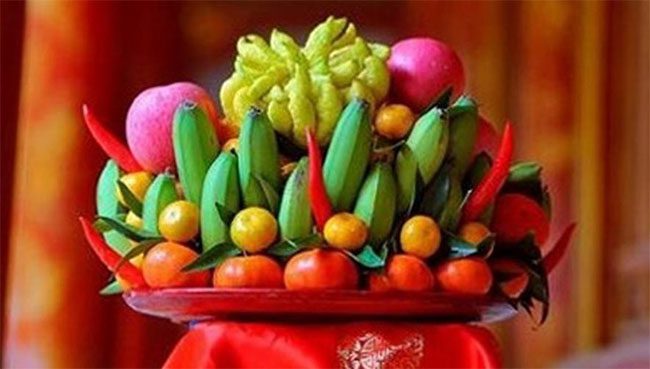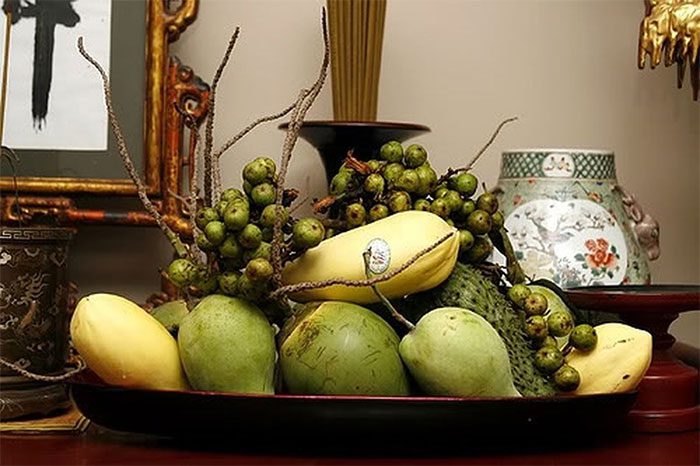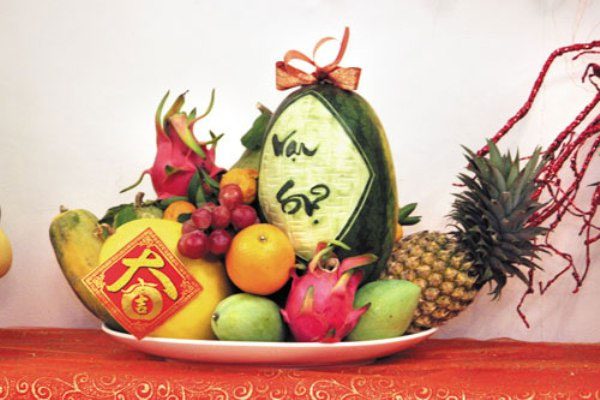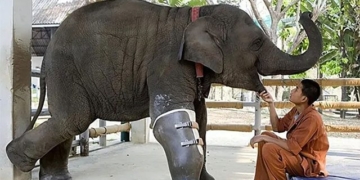The five-fruit tray on the altar during Tet not only serves as decoration but also holds many important spiritual meanings in our national tradition.
Why is there always a five-fruit tray on the Tet altar?
What is a five-fruit tray?
A five-fruit tray refers to a tray of fruit consisting of approximately five different types of fruits that are typically arranged for the Lunar New Year (Tet) celebration in Vietnam. This tray is often displayed on the ancestral altar or the guest table.
The fruits chosen usually reflect the wishes of the household based on their names, colors, and arrangement.
Nowadays, the arrangement of the five-fruit tray for Tet has taken on many decorative meanings beyond its original spiritual significance.
Traditional viewpoints
During Tet, almost every family’s ancestral altar features a five-fruit tray, which is not only visually appealing but also symbolizes the household’s wishes for the upcoming new year.
The five-fruit tray originates from the concept of yin-yang and the five elements, representing the harmony of all things with nature. According to ancient materialist theory, all matter is composed of five primary elements: “Metal – Wood – Water – Fire – Earth”.
It also embodies the principle of remembering one’s roots and shows respect toward ancestors. Additionally, the five fruits symbolize the fruits of a year’s hard work by farmers.
These products are the culmination of the sweat and labor of hardworking people through the harvest seasons. When spring arrives with warm sunshine, they take the opportunity to respectfully offer them to their ancestors.

The number 5 is considered very auspicious in feng shui, representing sustainable and strong development.
The number 5 – “five” – corresponds to the five elements and is regarded as a very auspicious number in feng shui, symbolizing sustainable and strong growth.
Therefore, the five-fruit tray on the altar represents the desire for harmony between yin and yang, fertility, and development.
There are no specific standardized fruits for the five-fruit tray; it varies by region and locality, leading to different selections of fruits in each area.
Five-fruit trays in the three regions: North, Central, and South
People in the North arrange their five-fruit trays according to the Five Elements theory in Eastern culture, representing the harmony of all things with nature.
Thus, the tray must also incorporate five colors: “White for Metal, Green for Wood, Black for Water, Red for Fire, Yellow for Earth”.
The arrangement of colors among the different fruits is interspersed to create a visually appealing and auspicious display for Tet. While there is no strict rule regarding the quantity of fruits, everyone strives to prepare enough offerings, and the fruits must align with their meanings for the offerings.
- The Northern five-fruit tray typically includes: Bananas, Grapefruit, Peaches, Persimmons, and Tangerines. The traditional arrangement has bananas at the bottom, supporting all other fruits. In the center is either a grapefruit or a golden Buddha’s hand fruit. The other fruits are arranged around it, with any empty spaces filled with golden tangerines and green apples…

Northern five-fruit tray.
- People in the South display their five-fruit tray based on the wish for “Sufficient abundance” for the new year, corresponding to five fruits: Custard Apple, Fig, Coconut, Papaya, and Mango.
- Additionally, they often include Pineapple with the hope of having many children and a pair of Watermelons with green skin and red flesh for good luck.
The Southern five-fruit tray reflects simplicity, rustic charm, and humor. Each person’s life and wishes differ, but everyone just wants enough.

Southern five-fruit tray.
- In the Central region, the five-fruit tray here is likely a blend of the two regions.
Moreover, the land here is often barren, with harsh climates and fewer fruits available, so the people do not emphasize the formality or significance of the five-fruit tray for Tet; they primarily offer what they have with sincerity to their ancestors.
Therefore, the five-fruit trays vary from household to household, and any fruit is acceptable as long as it is fresh. Common fruits include: Dragon Fruit, Bananas, Watermelon, Custard Apple, Pineapple, Fig, Orange, Tangerine…

Central five-fruit tray.
Meanings of different fruits
- Bananas: Symbolize the gathering of children and family, warmth, and the embrace of good luck, providing shelter and protection.
- Buddha’s Hand: This fruit is often chosen for offerings during Tet or on the 1st and 15th days of the lunar month. Not only does it have a light, pleasant fragrance, but its shape resembles a Buddha’s hand. This symbolizes a wish for protection and peace in a life filled with changes and uncertainties.
- Grapefruit: Represents wishes for peace and prosperity.
- Oranges and Tangerines: Symbolize success.
- Pomegranate: With many seeds, it symbolizes many children and grandchildren.
- Peach: Represents advancement.
- Apples: Wealth and prosperity. Apples are favored when offering on the altar. In feng shui, apples symbolize abundance. According to Greek mythology, the goddess Gaia gifted an apple to Hera when she wed Jesus, symbolizing blessings for enduring love and eternal reunion. In Chinese culture, the word for apple is a homophone for “peace.” Thus, apples are given as gifts to wish each other peace. In the context of ancestral worship, apples are chosen for offerings to convey heartfelt wishes for the deities’ blessings for abundance, peace, and family happiness.
- Dragon Fruit: Represents the gathering of clouds and symbolizes wealth.
- Watermelon: Round and refreshing, it promises sweetness and good luck.
- Eggs: A gift from heaven.
- Fig: Associated with abundance, health, and wealth.
- Papaya: Represents prosperity and abundance. The household wishes for sufficiency and prosperity in both life and career; thus, this fruit can be offered on the ancestral altar.
- Mango: The yellow color of mango symbolizes the Metal element, often associated with wealth. This fruit is also frequently placed on the Southern altar. In the South, people often pronounce mango as “xài,” symbolizing spending freely and living abundantly.
Common mistakes when arranging the five-fruit tray
Washing fruits properly for an attractive five-fruit tray
Many families buy fruits and often wash them carefully to make them look nice. However, washing fruits can cause them to wilt or rot if water is trapped in any spots. Therefore, simply wiping the fruits with a damp paper towel is sufficient. For grapefruits with yellowed or moldy skin, you can mix a little clean lime water and soak a cloth to wipe the grapefruit evenly, ensuring the skin looks fresh without the risk of water trapping and causing wilting.
Choosing ripe and beautiful fruits
Typically, the five-fruit tray should be ready before the evening of the 30th of Tet, and families usually arrange it on the morning or afternoon of the 30th. However, buying fruits can occur much earlier. Due to work, many families may purchase fruits from the 27th to 28th of Tet, or even earlier.
Thus, if one does not consider that the tray will be displayed from the 30th Tet until a few days later (usually until the family finishes celebrating Tet), choosing only beautifully ripe fruits may lead to them becoming overripe, wilting, or spoiling by the time of display.
It’s best to select fruits that are mature but not overly ripe (depending on how close the purchase date is to the 30th of Tet). Bananas should definitely be green (to be firm enough to support the other fruits and to ensure color symbolism according to the Five Elements); Fruits like mangoes, custard apples, papayas, and persimmons should be slightly unripe to avoid spoilage. Watermelons should have a green skin and red flesh, representing nobility and virtue. Regardless of the variety of fruits, it is also advisable to include Buddha’s Hand fruit, resembling a Buddha’s hand symbol.
Fruits to avoid displaying
Fruits that are spicy or bitter
When arranging the five-fruit tray for Tet, be sure to avoid fruits that are spicy, bitter, or overly sour. There is a belief that “what goes up must come down,” and offering bitter fruits to the deities won’t be appreciated.
Therefore, fruits that are spicy, bitter, or too sour should not be placed on the ancestral altar or in the Tet offering meals.
Fruits with thorns
Fruits with thorns, such as jackfruit and durian, should also not be displayed in the five-fruit tray during Tet.
According to many people’s beliefs, the thorns of certain fruits can offend the deities, and thus displaying these fruits at the beginning of the year may lead to a year filled with obstacles and difficulties in work, life, and family.
Fruits used for offerings must first meet the requirement of being round and regular in shape, with smooth, shiny skin, as they carry positive energy, symbolizing smoothness and favorable outcomes. Additionally, the round shape represents heaven (heaven is round, earth is square), reflecting the sincere heart of the person making the offering.
Fruits that are misshapen, have many scars, thorns, are overripe, or damaged should be avoided as they bring negative energy and should not be placed on the five-fruit tray for the Lunar New Year.
Overripe Fruits
Offering fruits on the altar often involves burning a lot of incense, which raises the temperature higher than usual. Therefore, placing fruits that are already ripe or showing signs of early ripeness on the altar will cause them to ripen even faster and become spoiled.
When fruits spoil, they attract flies, mosquitoes, and various decomposing microorganisms, leading to an unpleasant odor. This makes the altar for deities, ancestors, and grandparents less clean.
Fruits with Strong Odors
The best fruits for offering during the Lunar New Year are those with a light, pleasant fragrance that lingers. A subtle fragrance is not only good for the environment but also demonstrates respect for the deities and ancestors—beings of great wisdom.
Therefore, it is advisable not to choose fruits with overly strong smells, such as durian or jackfruit, for the altar. The altar is a sacred and tranquil place, so only fruits with light and delicate aromas should be selected.
Fruits Growing Close to the Ground
Fruits that grow close to the ground or are related to vegetables, such as tomatoes, tamarind, or pineapples, are also rarely chosen for the offering tray.
Fake Fruits
Feng Shui experts always advise against offering fake fruits, as this is considered a disrespectful act towards ancestors and is not good for Feng Shui.
Conclusion
The five-fruit tray during the Lunar New Year is a distinctive cultural feature of the Vietnamese people. Although it varies between regions, it fundamentally expresses reverence for ancestors and the hope for a new year filled with peace, happiness, and abundance.




















































